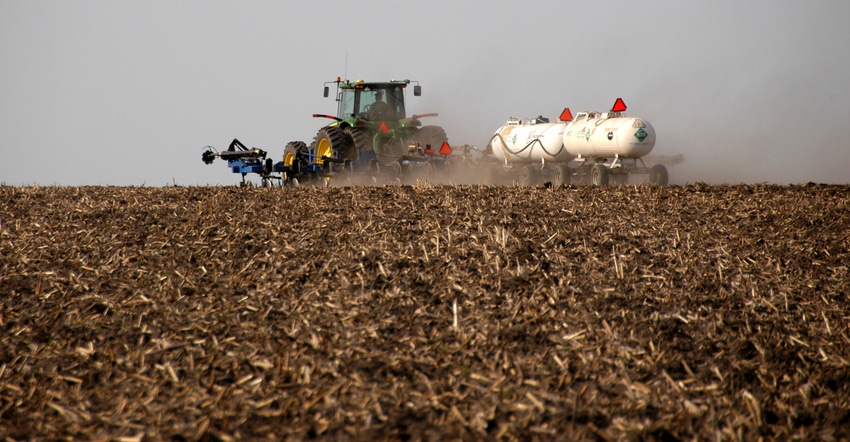
The right rate and timing for nitrogen fertilizer in corn for the upcoming growing season can be as unpredictable as the weather. Weather and soil nitrogen complicate the needed rate of anhydrous ammonium, depending on when and how it’s applied, says Emerson Nafziger, a University of Illinois crop scientist and emeritus professor.
Nafziger’s recent nitrogen fertilizer trials throughout the state are yielding new data for the Maximum Return to Nitrogen Rate Calculator. He says the calculator, which is now available on Apple iPhones, “won’t change very much” in its upcoming winter update, which adds the 2018 growing season data to the previous years informing the rate calculator.
“The 2015 growing season was marked by having record-high rainfall in June. We needed more nitrogen that year than we needed before and than we’ve needed since,” Nafziger says. “2016 was the other way around, where 150-pound rates [on corn after soybeans] tended to be enough.”
The 2018 growing season, on the other hand, had a cold, wet April followed by a very warm May, and then variable rainfall after that — with parts of western Illinois too dry and other parts of the state with more water than was ideal.
Both factors limited roots developing or fully functioning in some fields or parts of fields.
“People that look at low spots that get wet in the spring and where the corn is sickly and conclude that this is a result of most of the nitrogen being gone — most of the time, it actually isn’t gone. But the root system’s ability to take up the nitrates from 1 or 2 feet in the soil is compromised in wet soil,” Nafziger says of pale-green corn identified as nitrogen-deficient.
Corn that’s not fertilized, which normally averages about 150 bushels in Illinois trials, first revealed deficiencies when it was less than knee-high in 2018, which Nafziger says is unusually early.
“How much soil nitrogen is going to become available from soil organic matter to the crop is very unpredictable,” Nafziger says. “The nitrogen supply early in the season, when the crop starts to grow, may be more important in some ways than we think.”
Sidedressing N?
In trials across the state for 2018, front-loading with anhydrous ammonia applications in spring or fall yielded better than fields that had some nitrogen applied at planting and the rest applied as the crop was growing.
“Applying 50 pounds at planting, then sidedressing 150 pounds sounds ideal. You’re putting the bulk of nitrogen on when the crop needs to take it up, and in a wet year like 2015, it was a very effective treatment,” Nafziger says.
Sidedressing was an effective treatment in the 2017 growing season as well, he says, adding that the lower yield from this treatment in 2018 was a surprise. Right now, he says he can only conclude that plants experienced some deficiency after receiving a low amount of nitrogen early on. The rest of the nitrogen applied later was not in time to fully counteract the early deficiency, Nafziger says.
“We may, in ways that we don’t understand, be limiting yield on that crop such that later nitrogen is not going to make it all up,” he says.
Ammonium from anhydrous ammonia inevitably breaks down to nitrate, which moves with water, Nafziger says. “But it can be all nitrate by April, and as long as you don’t get those heavy rains, it won’t move down and out of the soil.”
A best guess
Nafziger calls the MRTN calculator he helped develop a “best guess based on a lot of previous research.”
“The rate suggested by the calculator is almost never exactly right for a given field in a given year, but in [Illinois] soils, 180 pounds of nitrogen is very likely to maximize your return on nitrogen over the years and over fields,” Nafziger says.
He says he’s worked on fields that have needed more nitrogen than average.
“This year we saw some rates as high as 250 pounds needed to bring yields up to their full level, and that’s higher than we typically see,” Nafziger says. “This isn’t related to the high yields of the crop; in fact, roots in dry soil can’t really grow or take up nitrogen very well, so we may need higher levels in the soil in order for the plant to take up enough to support the lower yield coming from inadequate water.”
He suggests some farmers might want to establish small trials on their farms. By fertilizing a strip with 60 or 80 pounds more nitrogen than in the rest of the field — and leaving another strip with a low rate such as 100 pounds of nitrogen — yields will tend to show that modest fertilizer applications are the most economically profitable option.
“We need to get away from this idea that every pound of nitrogen that crop is going to take up, we have to put on as fertilizer, because it just doesn’t work that way. Our soils have a lot of nitrogen in their organic matter, and we need to take advantage of that supply,” Nafziger concludes.
About the Author(s)
You May Also Like




